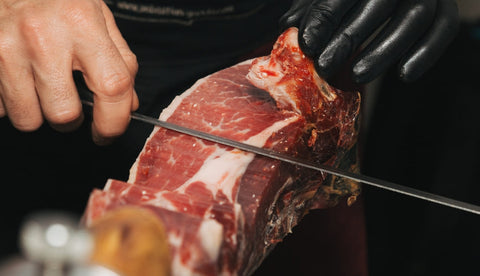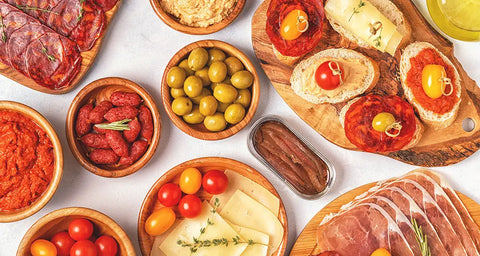Iberian ham, with its exceptional quality and rich cultural heritage, stands as a culinary gem renowned worldwide. This prized delicacy, originating from the Iberian Peninsula in Spain, holds a significant place in gastronomy. Its distinct flavor, unique characteristics, and deep-rooted traditions make it a sought-after indulgence for food enthusiasts. Let us delve into the captivating world of Iberian ham, exploring its origins, meticulous production process, and the cultural and economic significance it embodies.
The Rich Heritage of Iberian Ham:History and Tradition
The origin and tradition of Iberian ham have deep roots in the Iberian Peninsula, particularly in Spain. Its tradition and prestige in Spanish gastronomy are undeniable.
The Iberian pig, commonly known as "pata negra" due to the black color of its hooves, is the fundamental basis for the production of Iberian ham. This native breed has been raised on the Iberian Peninsula for centuries and is renowned for its adaptation to the environment and its ability to take advantage of the natural resources found in the "dehesas."
Dehesas are extensive wooded and pasture areas where Iberian pigs are raised in free-range conditions. These forests are primarily composed of holm oaks and cork oaks, whose acorns are an essential source of food for the pigs. It is within this unique environment that the Iberian pigs feed naturally and acquire the distinctive flavor and aroma that characterize Iberian ham.
The production of Iberian ham also has a long-standing tradition rooted in artisanal practices. After the pigs are slaughtered, the curing process begins with salting. Coarse sea salt is rubbed onto the meat to dehydrate it and enhance its preservation. Subsequently, the hams are washed and left to air-dry for a specific period of time.
The maturation stage is crucial for the development of the flavor and texture of Iberian ham. The hams are hung in cellars or natural drying rooms, where they undergo gradual changes in temperature and humidity. During this process, which can last several years, fat infiltrates the muscular tissue, providing juiciness and flavor to the final product.
The tradition of Iberian ham is deeply ingrained in Spanish culture. It is considered a gourmet product and is used in numerous celebrations and festivities, such as weddings, Christmas, and family gatherings. Additionally, Iberian ham is highly esteemed in Spanish cuisine and is used in a wide variety of dishes, ranging from tapas to main courses.
Quality and Unique Characteristics of Iberian Ham
Iberian ham stands out for its exceptional quality and unique characteristics, making it a highly prized delicacy in the world of gastronomy. Here are some key points highlighting its quality and distinctive features:
-
Feeding and rearing: One of the main factors contributing to the quality of Iberian ham is the feeding of Iberian pigs. These animals are raised in free-range conditions in the dehesas, where they have access to natural pastures. During the montanera, the period when acorns are plentiful, they primarily feed on acorns and other natural resources. This acorn-based diet leads to a higher intramuscular fat marbling, resulting in a juicy texture and a unique flavor in the ham.
-
Breed and genetics: The Iberian pig is a native breed of the Iberian Peninsula that has adapted over the years to take advantage of the environmental conditions and natural resources. Its specific genetics and the ability to accumulate infiltrated fat within the muscle are key elements in achieving the distinctive quality of Iberian ham.
-
Curing process: The curing process of Iberian ham is long and meticulous. The combination of salting, drying, and maturation in cellars or natural drying rooms is essential for developing its characteristic flavor and texture. The duration of this process can vary from several months to several years, depending on the type of ham and the desired quality.
-
Aroma and flavor: Iberian ham is renowned for its unmistakable aroma and intense, complex flavor profile. Its taste can range from sweet and mild to more intense and smoky, depending on factors such as the pig's breed, its diet, and the length of the curing period.
-
Texture and juiciness: The infiltration of fat into the muscle tissue of Iberian ham contributes to its smooth texture and juiciness. This fat, rich in monounsaturated fatty acids, melts at room temperature, adding to the luscious mouthfeel of the ham.
In summary, the quality and unique characteristics of Iberian ham stem from the natural feeding of Iberian pigs, their special genetics, the meticulous curing process, and the result of a long-standing tradition of artisanal production. These elements combine to offer a high-quality product with exceptional aromas, flavors, textures, and juiciness that make Iberian ham a highly sought-after gastronomic delight worldwide.
Denominations of Origin and Classification Systems for Iberian Ham
Iberian ham is subject to specific Denominations of Origin (DO) and classification systems in order to guarantee its quality, authenticity, and geographical origin. Here are some key points about denominations of origin and classification systems related to Iberian ham:
-
Denominations of Origin (DO): In Spain, different regions have established Denominations of Origin for Iberian ham. These include Jabugo, Guijuelo, Dehesa de Extremadura, Los Pedroches, and others. Each DO has its own regulations and criteria that producers must adhere to in order to use the designated name for their Iberian ham. These regulations cover aspects such as geographic boundaries, pig breed, feeding, production methods, and curing times.
-
Pig breed purity: The purity of the pig breed is an important criterion in the classification of Iberian ham. To be classified as Iberian ham, the animal must be at least 50% Iberian breed. The purity of the breed is typically denoted as "pure Iberian" (100% Iberian breed) or "crossbred" (crosses between Iberian and other breeds). The purity of the breed can have an impact on the flavor, texture, and quality of the final product.
-
Feeding and rearing conditions: The feeding and rearing conditions of the pigs play a significant role in the classification of Iberian ham. The use of the term "bellota" indicates that the pigs were fed a diet based on acorns and natural resources during the montanera period, while "cebo de campo" indicates a diet of natural pastures and feed supplements. The type of feeding and the time spent in the dehesas can influence the final quality and flavor of the ham.
-
Quality grades: Within each Denomination of Origin, Iberian ham is often classified into different quality grades. These grades are based on criteria such as the pig's diet, age at slaughter, genetics, and the duration of the curing process. Common quality grades include "bellota" (acorn-fed), "cebo de campo" (pasture-fed), and "cebo" (feed-fed). Each grade represents a specific level of quality and flavor intensity.
-
Certification and traceability: Denominations of Origin and classification systems for Iberian ham provide a framework for certification and traceability. Independent certifying bodies verify that the production processes comply with the established regulations, ensuring that the Iberian ham meets the specified quality standards. This certification and traceability system allows consumers to have confidence in the authenticity and origin of the product they are purchasing.
In conclusion, denominations of origin and classification systems for Iberian ham ensure that specific quality standards are met, guaranteeing the authenticity and geographical origin of the product. These systems provide consumers with confidence in the quality and characteristics of the Iberian ham they are purchasing, and they contribute to the preservation of traditional production methods and regional identities associated with this prized delicacy.
Elaboration Process
The elaboration process of Iberian ham is an art that combines traditional techniques and meticulous care. Here are the key steps in its production:
-
Slaughtering and salting: Once the Iberian pigs have reached the proper weight, they are slaughtered. Then, the salting process begins, which involves covering the meat with sea salt to dehydrate it and remove moisture. During this step, the salt is rubbed onto the surface and a specific amount of salt is applied based on the weight of the piece. Salting helps preserve the ham and gives it its distinctive flavor.
-
Washing and settling: After salting, the hams are washed to remove excess salt and then allowed to settle in special chambers for a specific period. During this time, the flavors settle and balance, preparing the pieces for the next phase of the process.
-
Drying and maturation: Following washing and settling, the hams are hung in cellars or natural drying rooms. Here, they undergo controlled, gradual changes in temperature and humidity, allowing the meat to slowly dry. During this stage, which can last several months or even years, the flavor and texture of the ham develop and intensify. Fat infiltrates the muscle tissue, contributing to the juiciness and distinctive flavor of Iberian ham.
-
Refinement and quality control: During the maturation process, the hams undergo strict quality control. Each piece is regularly monitored to assess its progress and ensure it meets the established quality standards. Experts evaluate the aroma, taste, texture, and visual appearance of the ham to ensure it meets the expected quality requirements.
-
Packaging and commercialization: Once the ham has reached the appropriate level of maturation, it is ready for packaging. The hams are typically cut into smaller portions, such as slices or boneless packages. They are then packaged and labeled with relevant information, such as the denomination of origin and the quality grade.
The elaboration process of Iberian ham requires patience, expertise, and a deep understanding of traditional techniques. Each step contributes to the final quality of the product, resulting in an exquisite Iberian ham with a rich flavor, juicy texture, and unmatched aroma.
Cultural and Economic Value
The cultural and economic value of Iberian ham is significant, both in Spain and internationally. Here are the key aspects highlighting its importance:
-
Cultural heritage: Iberian ham is deeply ingrained in the cultural heritage of Spain. It is considered a symbol of gastronomy, representing centuries-old traditions and culinary expertise. It is often featured in traditional celebrations, family gatherings, and special occasions, reflecting the cultural significance and pride associated with this prized delicacy.
-
Regional identities: Different regions in Spain, such as Jabugo, Guijuelo, and Dehesa de Extremadura, have their own denominations of origin for Iberian ham. These regions have developed distinctive production methods and flavor profiles, contributing to the unique regional identities associated with their hams. Iberian ham plays a vital role in preserving and promoting the cultural heritage and identity of these regions.
-
Tourism and local economies: The production and consumption of Iberian ham have a significant impact on tourism and the local economies in the regions where it is produced. Many tourists are drawn to Spain specifically to experience the culture and gastronomy, including indulging in the flavors of Iberian ham. This drives tourism revenue and supports local businesses, such as ham producers, farmers, restaurants, and artisans involved in the ham industry.
-
Employment and rural development: The production of Iberian ham provides employment opportunities, particularly in rural areas where the dehesas are located. Farmers, herders, ham producers, and other related industries contribute to job creation and the sustainability of rural communities. The economic activity generated by Iberian ham production helps maintain the vitality of these regions and supports the preservation of rural traditions.
-
Export and international recognition: Iberian ham has gained international recognition as a gourmet product, attracting consumers and gastronomic enthusiasts worldwide. The export of Iberian ham contributes to Spain's economy and trade balance. Its reputation for exceptional quality and unique flavor has led to increased demand in global markets, further enhancing its economic value.
In summary, the cultural and economic value of Iberian ham lies in its significance as a cultural symbol, its association with regional identities, its contribution to tourism and local economies, its role in employment and rural development, and its international recognition. It represents a true gastronomic treasure that transcends borders and continues to captivate individuals with its rich heritage and unparalleled flavors.
Conclusion
In conclusion, Iberian ham holds great cultural and economic value. Its cultural heritage, regional identities, and role in traditional celebrations underscore its cultural significance in Spain. The distinct denominations of origin and regional production methods add to the uniqueness and pride associated with Iberian ham. Moreover, it serves as a tourist attraction, contributing to local economies and supporting employment in rural areas. The export of Iberian ham has elevated its international recognition and stimulated economic growth. Overall, Iberian ham represents a true culinary treasure that combines centuries-old traditions, exceptional quality, and unmatched flavors, making it a symbol of gastronomy and a key driver of cultural and economic vitality.




